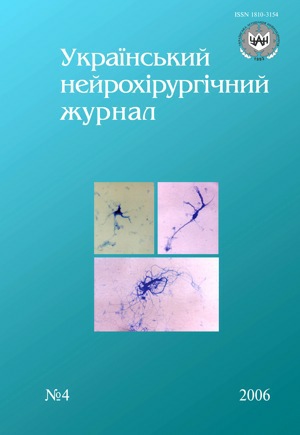Venospondylography as control and diagnostic method under the percutaneous vertebroplasty
DOI:
https://doi.org/10.25305/unj.128199Keywords:
venospondylography, vertebroplastyAbstract
Venospondylography is a method, potentially capable to predict possible movement of bone cement during vertebroplasty out from the vertebral body. Leakage of bone cement into epidural venous plexuses can cause spinal cord and nerve roots compression. Leakage into paraspinal veins can lead to polymerization init and pulmonary embolism.
48 patients during 2000-2006 have been operated by vertebroplasty on the thoracic and lumbar spine in cases of hemangiomas of vertebrae, metastatic tumors, osteoporotic and traumatic uncomplicated fractures of vertebrae 59 levels. At 48 patients vertebroplasty was made in 12 levels bilateral vertebroplasty was carried out. At 21 patients of I group before vertebroplasty venography studying was not performed (vertebroplasty was made at 26 levels). At 27 patients of II group before performing vertebroplasty the systemic venography was made (at all levels it was performed 33 venospondylography and was executed 33 vertebroplasty).
It was noted, that in the second group it was appreciable below percent of complications. In the first group it was 26,9 %, in the second — 3 % of complications. The only case in which the venography was made and it was epidural spreading contrast was a case with a hemangioma of a body of a vertebra in which too liquid bone cement was used. There is case with serious complications in the first group where the additional operative procedures and time hospitalization was required.
Venospondylography is an important diagnostic method, allowing to prognosticate an exit of bone cement in venous drainages of a vertebral body. Basing on data of venospondylography it is probable effectively to prevent an exit of bone cement out of vertebral body.
References
Педаченко Е.Г., Кущаев С.В. Пункционная вертебропластика. // Киев. — 2005.
Burton A.W., Rhines L.D., Mendel E. Vertebroplasty and kyphoplasty: a comprehensive review. // Neurosurg. Focus. — 2005. — V.18 (3) . — E1
Deramond H., Depriester C., Galibert P., Le Gars D. Percutaneous vertebroplasty with polymethyl-methacrylate: technique, indications, and results. // Radiol. Clin. North.-Am. — 1998. —V.36. —P.533 -54
Gaughen J.R., Jensen M.E., Schweickert P.A., Kaufmann T.J., Marx W.F., Kallmes D.F. Relevance of Antecedent Venography in Percutaneous Vertebroplasty for the Treatment of Osteoporotic Compression Fractures. // American Journal of Neuroradiology. — 2002. — V.23. —P.594-600
Hierholzer J., Fuchs H., Westphalen K., Venz S., Pappert D., Depriester C. Percutaneous vertebroplasty — the role of osseous phlebography. // Rofo. — 2005. —V.177(3) . —P.386-92.
Jensen M.E., Evans A.J., Mathis J.M. Percutaneous polymethylmethacrylate vertebroplasty in the treatment of osteoporotic vertebral body compression fractures: technical aspects. // Am. J. Neuroradiol. —1997. —V.18. —P.1897-1904.
Kallmes D.F., Jensen M.E. Percutaneous Vertebroplasty. // Radiology. — 2003. —V.229. —P.27-36.
Lee B.J., Lee S.R., Yoo T.Y. Paraplegia as a complication of percutaneous vertebroplasty with polymethylmethacrylate: a case report. // Spine. — 2002. —V.27(19) . —P.419-22.
Lieberman IH, Dudeney S, Reinhardt MK, et al: Initial outcome and efficacy of “kyphoplasty” in the treatment of painful osteoporotic vertebral compression fractures. // Spine. — 2001. —V.26. —P.1631–1638
Mathis JM, Barr JD, Belkoff SM, Barr MS, Jensen ME, Deramond H. Percutaneous vertebroplasty: a developing standard of care for vertebral compression fractures. // A.J.N.R. — 2001. —V.22. —P.373-381
McGraw JK, Heatwole EV, Strnad BJ, Silber JS, Patzilk SB, Boorstein JM. Predictive value of intraosseous venography before percutaneous vertebroplasty. // J. Vasc. Interv. Radiol. — 2002. —V.13. —P.149-153.
McGraw JK, Strnad BT, Patzik SB, Silber JS, LaValley AL, Boorstein JM. Carbon dioxide and gadopentetate dimeglumine venography to guide percutaneous vertebroplasty. // Cardiovasc. Intervent. Radiol. — 2000. — V.23(6) . —P.485-7.
Peh W.C.G., Gilula L.A. Additional Value of a Modified Method of Intraosseous Venography During Percutaneous Vertebroplasty. // A.J.R. — 2003. — V.180. —P.87-91
Perez-Higueras A, Alvarez, L, Rossi RE. Percutaneous vertebroplasty: long-term clinical and radiological outcome. // Neuroradiology. —2002. —V.44. —P.950–954
Rauschmann MA, von Stechow D, Thomann KD, Scale D. Complications of Vertebroplasty. // Orthopade. — 2004. —V.33(1) . — P.40-7.
Tanigawa N, Komemushi A, Kariya S, Kojima H, Sawada S. Intraosseous venography with carbon dioxide contrast agent in percutaneous vertebroplasty. // A.J.R. Am. J. Roentgenol. — 2005. —V.184(2) . —P.567-70.
Vasconcelos C., Gailloud P., Beauchamp N.J., Heck D.V., Murphy K.J. Is Percutaneous Vertebroplasty without Pretreatment Venography Safe? Evaluation of 205 Consecutives Procedures. // American Journal of Neuroradiology. — 2002. —V.23. —P.913-917
Villavicencio A.T., Burneikiene S., Bulsara K.R. and J.J. Thramann, M.D. Intraoperative three-dimensional fluoroscopy-based computerized tomography guidance for percutaneous kyphoplasty. // Neurosurg. Focus. — 2005. — V.18 (3) . —E3
Wong W., Mathis D.O., Mathis J. Is Intraosseous Venography a Significant Safety Measure in Performance of Vertebroplasty? // Journal of Vascular and Interventional Radiology. — 2002. — V.13. —P.137-138.
Downloads
How to Cite
Issue
Section
License
Copyright (c) 2006 E. I. Slynko, V. V. Verbov, A. I. Trojan, V. V. Moroz

This work is licensed under a Creative Commons Attribution 4.0 International License.
Ukrainian Neurosurgical Journal abides by the CREATIVE COMMONS copyright rights and permissions for open access journals.
Authors, who are published in this Journal, agree to the following conditions:
1. The authors reserve the right to authorship of the work and pass the first publication right of this work to the Journal under the terms of Creative Commons Attribution License, which allows others to freely distribute the published research with the obligatory reference to the authors of the original work and the first publication of the work in this Journal.
2. The authors have the right to conclude separate supplement agreements that relate to non-exclusive work distribution in the form of which it has been published by the Journal (for example, to upload the work to the online storage of the Journal or publish it as part of a monograph), provided that the reference to the first publication of the work in this Journal is included.









